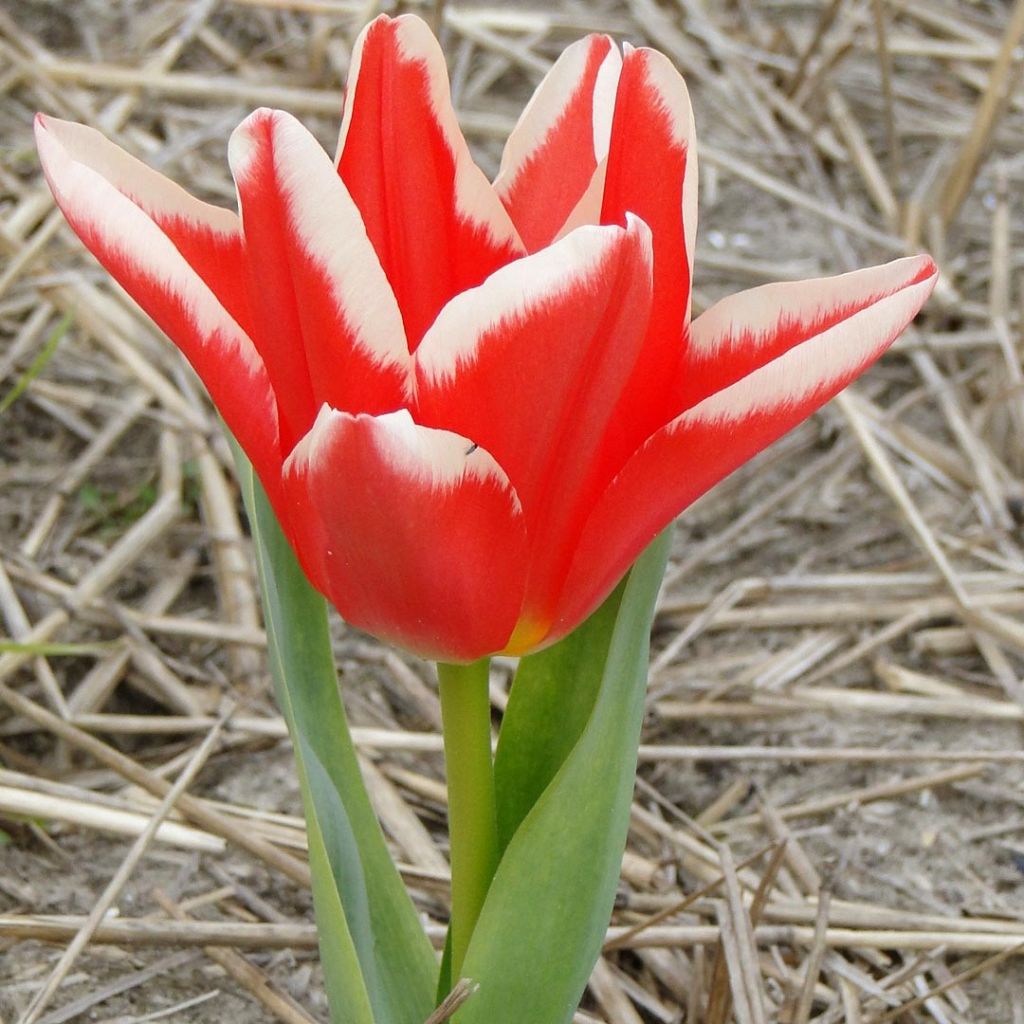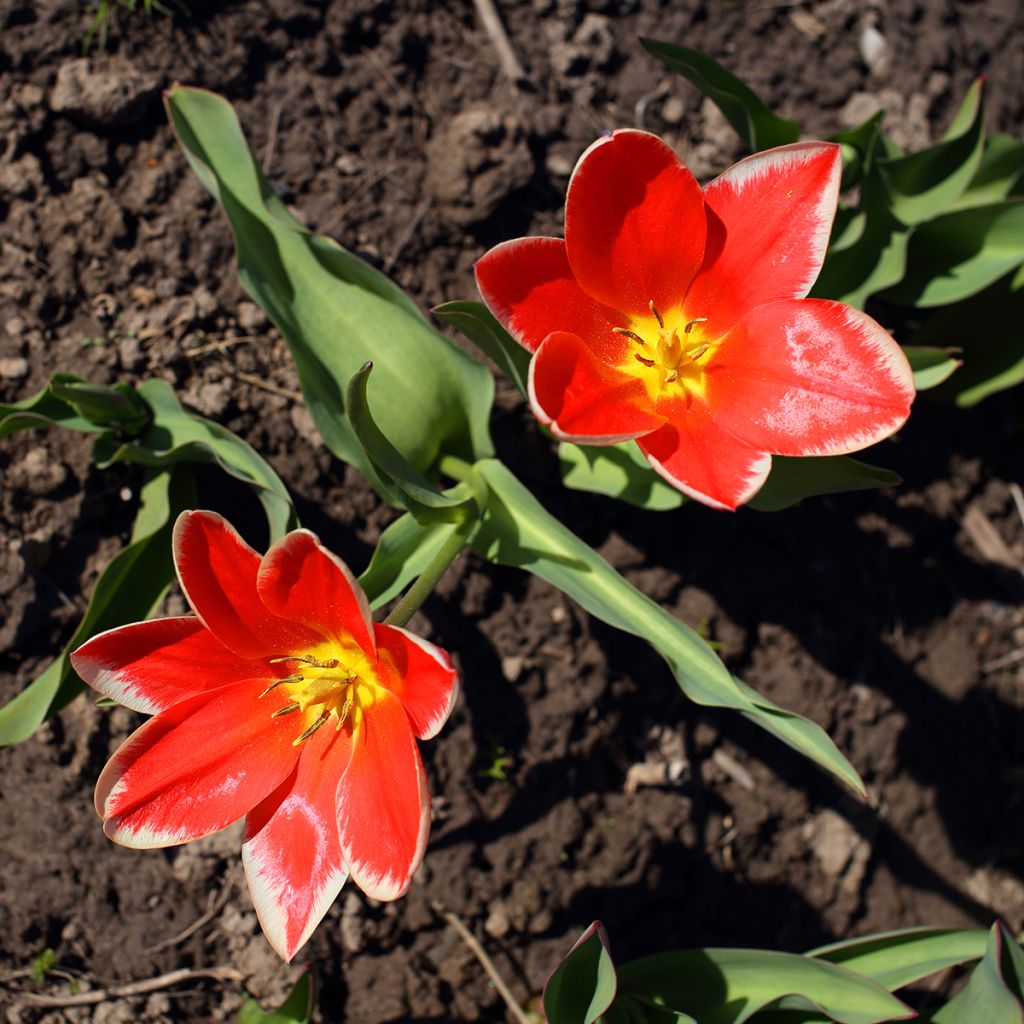

Tulipa fosteriana Pirand


Tulipa fosteriana Pirand
Tulipa fosteriana Pirand
Tulipa fosteriana Pirand
Fosteriana Tulip
Stunning
Jp, 17/03/2021
This plant carries a 6 months recovery warranty
More information
We guarantee the quality of our plants for a full growing cycle, and will replace at our expense any plant that fails to recover under normal climatic and planting conditions.
From €5.90 for pickup delivery and €6.90 for home delivery
Express home delivery from €8.90.

Does this plant fit my garden?
Set up your Plantfit profile →
Description
Tulipa 'Pirand' is an early-flowering variety known for its longevity in the garden, and its ability to naturalise in favourable soil. It bears large cherry-red flowers edged with white. The flowers are beautiful at every stage, until it fully opens into a star shape with a golden throat. The abundant foliage serves as a backdrop to the flowering. This vibrant tulip brings life to the garden from the early days of spring. It multiplies spontaneously and faithfully blooms every year.
Tulipa fosteriana is a hardy botanical species native to Turkestan. Tulips derived from T. fosteriana belong to division 13. They are reliable performers. They are among the first tulips to bloom, sometimes as early as March 15th. They naturalise and multiply easily, so there is no need to replace them regularly. This 'Pirand' variety was registered in 1997. It produces strong but flexible stems, 35 to 40cm (14 to 16in) tall, bearing at their tips a cup-shaped corolla, 12cm (5in) wide, fully bordered with white on a red background. It opens and broadens in the sun to reveal a deep and wide golden yellow throat. The foliage is dark green and wide. It dries up a few weeks after flowering, indicating the start of the bulb's summer dormancy.
Tulips from the Fosteriana Group work well in flower beds and borders. The taller varieties are ideal for bouquets. Their sparkling yet elegant colours pair well with blue hyacinths, grape hyacinths, forget-me-nots, and with other tulips. When designing your flower beds, you must consider the height and flowering period of the tulips, as these parameters can vary significantly from one cultivar to another. It is wise to plant extra bulbs for cutting, as they make gorgeous cut flowers that last a long time in a vase. This variety's bicolour flowers blend well with white, red, or pink tulips.
Report an error about the product description
Plant habit
Flowering
Foliage
Botanical data
Tulipa
fosteriana
Pirand
Liliaceae
Fosteriana Tulip
Cultivar or hybrid
Planting and care
Plant the bulbs as soon as possible in well-drained soil. They are happy with soil that is dry in summer. Loosen the soil deeply. Plant at a depth of 15cm (6in) (the bulbs should be covered with twice their height of soil). Space the bulbs a few cm apart, making sure they do not touch. Choose a sunny exposure for better flowering. After flowering, cut the flower stalks and let the leaves dry completely before cutting them. After flowering, their foliage becomes unsightly, so we recommend planting heuchera, tiarella, brunnera, bleeding heart, or Euphorbia cyparissia at the forefront of your flower beds. Their foliage will enhance the colours of your tulips, and will elegantly conceal the tulip's yellowed leaves.
Planting period
Intended location
Care
-
, onOrder confirmed
Reply from on Promesse de fleurs
Haven't found what you were looking for?
Hardiness is the lowest winter temperature a plant can endure without suffering serious damage or even dying. However, hardiness is affected by location (a sheltered area, such as a patio), protection (winter cover) and soil type (hardiness is improved by well-drained soil).

Photo Sharing Terms & Conditions
In order to encourage gardeners to interact and share their experiences, Promesse de fleurs offers various media enabling content to be uploaded onto its Site - in particular via the ‘Photo sharing’ module.
The User agrees to refrain from:
- Posting any content that is illegal, prejudicial, insulting, racist, inciteful to hatred, revisionist, contrary to public decency, that infringes on privacy or on the privacy rights of third parties, in particular the publicity rights of persons and goods, intellectual property rights, or the right to privacy.
- Submitting content on behalf of a third party;
- Impersonate the identity of a third party and/or publish any personal information about a third party;
In general, the User undertakes to refrain from any unethical behaviour.
All Content (in particular text, comments, files, images, photos, videos, creative works, etc.), which may be subject to property or intellectual property rights, image or other private rights, shall remain the property of the User, subject to the limited rights granted by the terms of the licence granted by Promesse de fleurs as stated below. Users are at liberty to publish or not to publish such Content on the Site, notably via the ‘Photo Sharing’ facility, and accept that this Content shall be made public and freely accessible, notably on the Internet.
Users further acknowledge, undertake to have ,and guarantee that they hold all necessary rights and permissions to publish such material on the Site, in particular with regard to the legislation in force pertaining to any privacy, property, intellectual property, image, or contractual rights, or rights of any other nature. By publishing such Content on the Site, Users acknowledge accepting full liability as publishers of the Content within the meaning of the law, and grant Promesse de fleurs, free of charge, an inclusive, worldwide licence for the said Content for the entire duration of its publication, including all reproduction, representation, up/downloading, displaying, performing, transmission, and storage rights.
Users also grant permission for their name to be linked to the Content and accept that this link may not always be made available.
By engaging in posting material, Users consent to their Content becoming automatically accessible on the Internet, in particular on other sites and/or blogs and/or web pages of the Promesse de fleurs site, including in particular social pages and the Promesse de fleurs catalogue.
Users may secure the removal of entrusted content free of charge by issuing a simple request via our contact form.
The flowering period indicated on our website applies to countries and regions located in USDA zone 8 (France, the United Kingdom, Ireland, the Netherlands, etc.)
It will vary according to where you live:
- In zones 9 to 10 (Italy, Spain, Greece, etc.), flowering will occur about 2 to 4 weeks earlier.
- In zones 6 to 7 (Germany, Poland, Slovenia, and lower mountainous regions), flowering will be delayed by 2 to 3 weeks.
- In zone 5 (Central Europe, Scandinavia), blooming will be delayed by 3 to 5 weeks.
In temperate climates, pruning of spring-flowering shrubs (forsythia, spireas, etc.) should be done just after flowering.
Pruning of summer-flowering shrubs (Indian Lilac, Perovskia, etc.) can be done in winter or spring.
In cold regions as well as with frost-sensitive plants, avoid pruning too early when severe frosts may still occur.
The planting period indicated on our website applies to countries and regions located in USDA zone 8 (France, United Kingdom, Ireland, Netherlands).
It will vary according to where you live:
- In Mediterranean zones (Marseille, Madrid, Milan, etc.), autumn and winter are the best planting periods.
- In continental zones (Strasbourg, Munich, Vienna, etc.), delay planting by 2 to 3 weeks in spring and bring it forward by 2 to 4 weeks in autumn.
- In mountainous regions (the Alps, Pyrenees, Carpathians, etc.), it is best to plant in late spring (May-June) or late summer (August-September).
The harvesting period indicated on our website applies to countries and regions in USDA zone 8 (France, England, Ireland, the Netherlands).
In colder areas (Scandinavia, Poland, Austria...) fruit and vegetable harvests are likely to be delayed by 3-4 weeks.
In warmer areas (Italy, Spain, Greece, etc.), harvesting will probably take place earlier, depending on weather conditions.
The sowing periods indicated on our website apply to countries and regions within USDA Zone 8 (France, UK, Ireland, Netherlands).
In colder areas (Scandinavia, Poland, Austria...), delay any outdoor sowing by 3-4 weeks, or sow under glass.
In warmer climes (Italy, Spain, Greece, etc.), bring outdoor sowing forward by a few weeks.


































